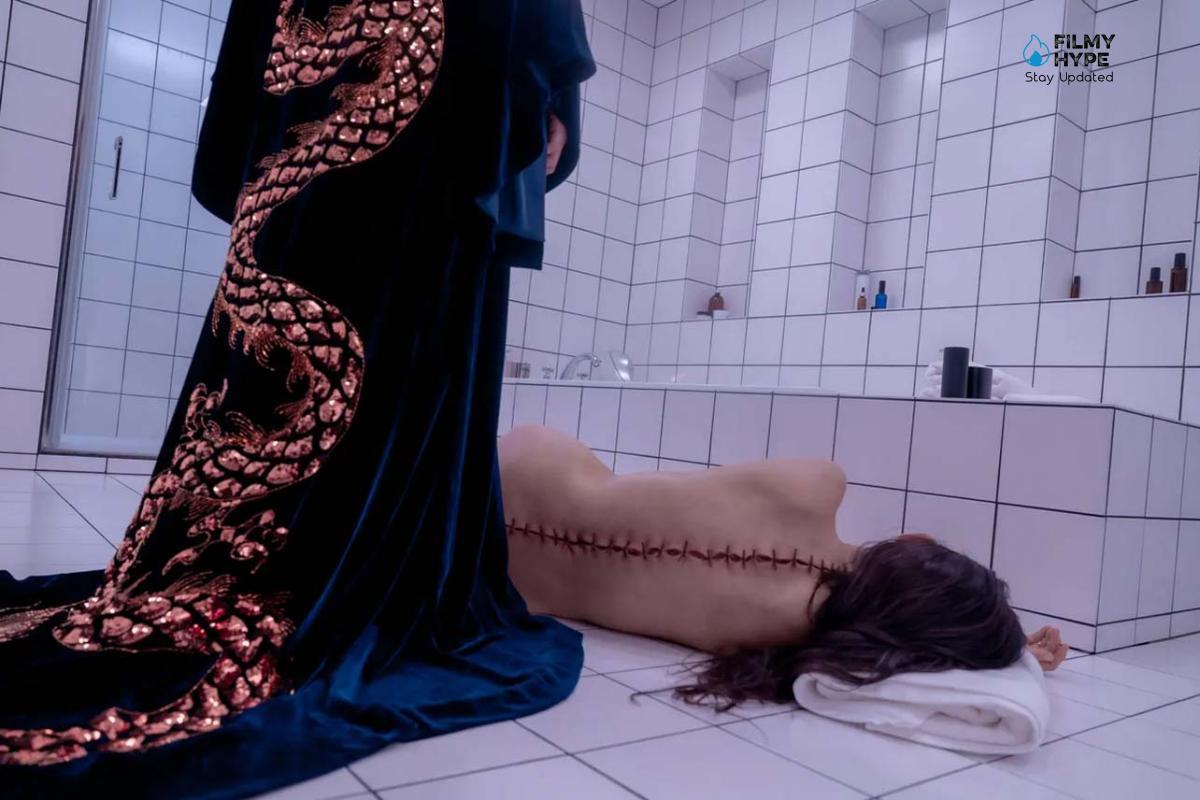The Substance Review: Horror Film Full of Gore, Very Funny and Capable of Transmitting | Cannes 2024
Cast: Demi Moore, Margaret Qualley, Dennis Quaid
Director: Coralie Fargeat
Where We Saw It: at the Cannes Film Festival
Filmyhype.com Ratings: 4/5 (four stars)
The Substance is the fulfillment of a prayer: that of having a film at Cannes 2024 capable of leaving a lasting mark, of giving something significant, and memorable, of doing it with audacity and above all with great creativity. Demi Moore, Margaret Qualley, and Dennis Quaid are the protagonists of a wild, unstoppable, magnificent body horror comedy, which confirms how much La Croisette is linked to the genre and above all knows how to propose incredibly innovative variations of it. It almost makes you smile that a film called The Substance has the limitation of lacking a bit of substance. The lightning-fast premise, excited development (the 140-minute duration is never felt), and spectacular ending in an unstoppable relaunch into the territory of the bloody and the grotesque almost make us forget how thin the premise of the entire operation is. On the other hand, often the most successful horror films are those whose ideas can be summed up in two lines written hastily on a napkin at the bar, à la Suspiria. Not the cultured and highly sought-after one by Guadagnino, but the original by Argento. Coralie Fargeat must have written down something like this on her imaginary paper napkin: a Hollywood star over 50 is willing to do anything to avoid getting old because she hates herself.

Working Title Films)
The Substance is all there and – deliberately – it is immersed in a version of Hollywood that is neither realistic nor political, but rather exaggerated, caricatural, grotesque. I am a little perplexed when I read about feminism and misogyny in a film that depicts a studio world as realistic as the omnipresent primary, bright, Almodovarian colors always paired with complementary ones (orange, blue, yellow, purple and so on) that permeate his plastic imagery. The Substance is fake, but that’s okay because it lets itself be guided by its visual dimension which crowns the bubblebum pink with blood red. As we will see in this review of The Substance, the film with Demi Moore and Margaret Qualley – who lend themselves to the most terrible situations with amused self-sacrifice – sets no limits whatsoever and explores the consequences of the society we have created – in particular by analyzing the Hollywood microcosm – about women’s lives, trying to disgust the viewer as much as possible. It is not work for weak stomachs, we must underline this, but if you let yourself be carried away on this infernal journey with the right awareness, we promise you, it will be one of the most exciting and entertaining titles you will see this year.
The Substance Review: The Story Plot
The Substance guides us in a world that is ours, but not ours, let’s say it resembles us, consider finding yourself in a uchronia that is a mix between the most plasticky 80s imaginable and the drift individualistic 21st-century technocrat. The protagonist is Elisabeth Sparkle (Demi Moore) who got her star on the Hollywood Walk of Fame, but time has passed, she has reached 50, and she is no longer the most desired woman. All that’s left of her myth is a fitness TV show. But that program, as she is told by her manager, the slimy and amoral Harvey (Dennis Quaid), will no longer be her program, she is too old, her beauty is gone, and they want a new face. Desperate, she gets involved in a car accident on the way back. Hospitalized, she is approached by a nurse, who says he can help her.
In a short time, through a mysterious organization, she is offered a sort of incredible pact with the devil: injecting herself with a mysterious substance, which will lead her to give birth, so to speak, to another her, but much younger, more beautiful, endowed with free will and independence. The two women will have a week each in the real world, with one stuck in some sort of stasis, but they are not two people, simply one person with two lives. Elisabeth in particular essentially acts as a biological reserve for her (Margaret Qualley), who however will naturally begin to take various liberties. Nothing will go as expected, because the very young and beautiful clone will become the new star of the television program, finally a celebrity, and then that precarious coexistence between the two will be completely broken, with effects that are nothing short of monstrous.

Working Title Films)
The Substance bears the signature of Coralie Fargeat, who confirms herself as an interesting and atypical director, aggressively feminist but never an end in itself. She gives us a crazy film, but above all capable of proposing different themes with interconnected and particularly interesting reading levels. The Substance is an extraordinary body horror comedy, the likes of which we haven’t seen in a long time, and which turns the clock back to those fabulous 80s of cinematic counterculture. There are obvious homages and connections with the cinematography of Yuzna, Carpenter, and Cronenberg. We laugh, we are horrified, and above all, we are never indifferent to a story that is a sort of dark pop fairy tale, apparently second rate, but in reality a very refined authorial product.
The Substance Review and Analysis
The Substance is dominated by these two female pillars, Demi Moore and Margaret Qualley. The first was the sex symbol of the 90s, then she had a sort of not unlike her character. Qualley often mimics her, quotes her, and walks around armed with a body modified by an extraordinary make-up department, which makes her even more of a Barbie, much more than what we have had from Margot Robbie and Greta Gerwig. Everything in The Substance, from the direction to the glossy but cold photography, from the essential sets, aims to imprison us in a world that is almost exclusively for interiors, another element that winks at genre cinema. There is a clear attack on all the worst things that the mainstream American industry still produces today, the one that always tries to produce new bodies to adore, and new curves to sell.
Another dominant theme in The Substance is aging, the centrality of being young eternally and without conditions in modern society, the thought of being able to defeat time with surgery and the like, with the illusion that it is the only thing that matters. We talk very well about the problem linked to the female image in the media, the need to always and deliberately be connected to certain aesthetic canons, which don’t want to know about leaving or being seriously annihilated. Fargeat then also adds a touch of parody to the male-centric objectification, with a crescendo that leads to a final epiphany in which she mentions The Thing, Blob, in short, the many cornerstones of the body horror that was. If Moore is extraordinary in her ability to be everything and the opposite of everything, to move between irony and drama irresistibly, Qualley confirms herself as the most disturbing interpreter of her generation.
The Substance is vibrant and original, it is not afraid of anything or anyone, but it is also capable of sensitivity, of a veil of melancholy that hovers and touches us intimately, while we see this still beautiful woman not recognizing herself in the mirror. Extremely ferocious towards Showbiz and image culture, The Substance is a film that you absolutely cannot miss, it will be remembered as the symbolic work of Cannes 2024, which in other ways is quite disappointing. Now it remains to be understood how much such audacity will appeal overseas, also for the use of nudity, the explicitness of the contradictions of society 2.0 without sugarcoating the pill, a practice that is very little liked in America. Elizabeth’s surname is Sparkle, yet the spark that distinguished her among the stars of the City of Angels seems to have vanished, not only in the eyes of others but in those of the woman herself, who has founded an entire career on her body and appearance physicist. Elizabeth is part of Los Angeles and its star system, and she cannot accept that her star on the Walk of Fame is increasingly crumbling.

Working Title Films)
In The Substance, Fargeat immediately brings monstrosity to life, even when it is masked by beauty: the POV that accompanies the activation of the host body – which we already know is beautiful – still makes us uncomfortable, because we know that that beauty is the result of an operation we have performed on our body. What the director does is question the entire violent and repressive apparatus that ends up leaving traces and violence on women’s bodies. With a staging full of colors, red, yellow, blue, and pink, with a sound that amplifies any noise, with frenetic editing, Coralie Fargeat films the sexualized bodies of women, with close-ups and extreme close-ups of buttocks, legs, and necklines. Elizabeth is immersed in a system in which men – led by a perfect Dennis Quaid – demand beauty, dazzling smiles, and perfect performances from women. Fargeat frames them as brutes, dirty, uncouth, focusing on the messy way in which they eat, the noise of their chewing, and very close-ups of their penetrating gazes.
In The Substance, there are many colors, and very few words, the duration is extended to tell a story with a clear intent but it takes all the time to reach a completely delirious third act. When it seems that the story has ended in predictability, Coralie Fargeat ‘s signature emerges forcefully. Elizabeth/Sue’s inability to respect balance opens the door to the realm of the grotesque and the fantastic, with astonishing practical effects and great references to 80s horror films such as Society and The Fly regarding prosthetics and Stanley’s films Kubrick in the formal rigor, in the geometries and spaces of vivid colors that become places of horror, of slimy multiplication. The one at the center of The Substance is a reflection that goes very well with Demi Moore’s history with plastic surgery and with the actress’s return to the scene in a leading role after many years.
In this sense, it seems that Moore has given herself to the Fargeat project at the right time, in which she is ready to see herself age on the screen, dismantling and disfiguring her figure, her calling card, which crowned her one of the sex stars symbols of the 80s and 90s. Margaret Qualley is increasingly launched and convincing in these performance roles and body horror becomes the perfect scenario in which to work both on her body and her training as a dancer, her sinuous lines and toned body, as well as on her gaze – already exploited very well by Yorgos Lanthimos (Povere Creature!, Kinds of Kindness) – and on his very particular tone of voice. In The Substance, the survival instinct forges monstrosity: in wanting more and more, when the threat of disappearing forever becomes apparent, the morbid desire is no longer just distressing, but becomes physically repugnant, in stomach-churning sequences that will satisfy without fans of Julia Ducournau and David Cronenberg have no doubt.
If the first two acts for Fargeat are functional in conveying its message to the public (which is reiterated several times), which has little that is revolutionary and had been treated in many other films, the true originality of the work is discovered in the ending. After having bombarded us with images of physical perfection for almost an hour and a half, between continuous shots of perfect breasts and very firm butts, the film discovers its most sincere and monstrous soul in the final half hour, in which the protagonist suffers yet another transformation and The Substance takes gore and body horror to the extreme. The conclusion of the film is a real bloodbath, in a hell of violence and guts that borrows heavily from Cronenberg and a cult-like Carrie, leaving the viewer speechless. Fargeat’s film is another “Rape&Revenge” like his previous work: it is always the female body that is violated on several occasions (more objectified than ever) and the revenge is the final one of the protagonists, who takes it out on the public directly responsible for turning her into a monster.
In her previous work, Revenge, Coralie Fargeat had already transformed a house in the middle of the desert into a bloody bath of violence, where a hypersexualized woman takes revenge on her rapist. Here, there are many echoes of Revenge: the bright colors, the star, and heart earrings that recall those of Matilda Lutz, the second chance at life that is given to the protagonist. The Substance becomes a rape and revenge of the body and the soul, in which the boundaries between victim and executioner blur, we are the ones who create/give birth and we are the ones who hurt ourselves, dominated by a devouring desire that has been thrust upon us. The Substance is not a film for all tastes, that’s for sure, but if you manage to get involved and grasp the author’s intent (which is shown in all its splendor in the final sequence) we are sure that you will not forget it so easily.
The Substance Review: The Last Words
The Substance is a feminist horror film full of gore, very funny, and capable of transmitting its message with clarity and effectiveness. Amazing Demi Moore and Margaret Qualley. If the visual structure of The Substance, bright colors, lights, and the desire to define, as if they had to be cut by a scalpel, the contours of everything that appears on the screen, be it a character or an object, are reminiscent of Brandon’s works Cronenberg the themes are those of the most important Cronenberg, David: the double, the mutilation of bodies, suspended lives, criticism of the world of show business. Then there are winks to Carrie (especially the ending) and strong echoes of Death Becomes Her by Robert Zemeckis (in the way of downplaying and in the use of actresses). The closure of the story which is recomposed with the beginning adds value to the whole. Of course, The Substance adds nothing to what those who love the genre haven’t already seen, but everything is well told, solid and played very well by its protagonists. A beautiful vision.

The Substance Review: Horror Film Full of Gore, Very Funny and Capable of Transmitting | Cannes 2024 | Filmyhype

Director: Coralie Fargeat
Date Created: 2024-05-21 19:59
4
Pros
- Demi Moore and Margaret Qualley are amazing
- The clear and effective feminist message
- The final half hour of pure madness and fun
Cons
- The central part is perhaps a little too repetitive

